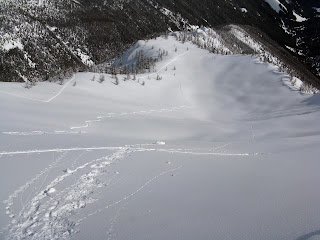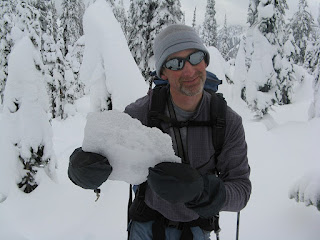Yesterday I led a trip for my local mountaineering club to Sandon Peak. Not a particularly hard trip for me, in fact, pretty easy and straight forward, but a difficult trip for many people in the club. On harder trips, making sure the entire group has the physical and technical skill and ability to complete the trip in a reasonable time frame is important. Epics and clusterfucks are born and bred when groups are both too disparate and too physically and technically weak for the objective. Screening and turning away non-qualified applicants is necessary.
Personally, I find generic screening questions (i.e. Are you fit? Are you a good skier?) do nothing to sort the qualified from the unqualified. Almost everyone will answer yes to both of those questions and tell you that they can always keep up with the group they normally ski with. Clearly, without knowing the group they normally ski with, this tells you nothing. A weak skier can easily keep up with an even weaker group, and, as people tend to gravitate towards people of their own skill, fitness and ability, "keeping up with their group" will, in all likelihood mean, that they are capable of skiing short distances and taking a long time to do so.
My preference is to ask very specific questions. Namely, "tell me about your last 3 to 4 trips and when you did them?" I am looking for people whose most recent trips have involved a similar amount of distance and elevation gain through similar terrain and conducted in a reasonable time frame to the trip I am planning.
On my last trip, I had an unknown person apply to come along. I asked exactly this: "what are the last three ski trips you've done and when did you do them?" In response to this very specific questions I got all kinds of information, but no answer to the question I asked. I was told how much the individual attempted to run and cross-country ski each week and had, the previous year, been on a hut based ski trip. But, no specific answer to my specific question.
I tried phrasing the question another way "what is a typical trip? how far will you go? how long will it take?' Again, lots of bluster about various things done in times past, but an answer that was remarkably short on detail. Interestingly, a friend of the participant in question contacted me (unsolicited) to vouch for the participant and was similarly fuzzy in his recommendation. Statements like "he will be an asset if the going gets tough" tell me nothing specific as I don't know what these people consider tough. Tough for them could well be easy for me, in which case, this trip might well be too hard. Eventually, many many questions later I felt as confident as possible that the trip was within the individuals ability, albeit, a bigger trip than normal and likely a stretch for him.
A less experienced trip leader would have a hard time in this circumstance recognizing that the barrage of information being provided does not address the basic issue - how far can you go in what time frame and what terrain can you manage? Much poking, prodding, questioning of both the participant and the participant's reference still did not leave me with clear answers to these questions. And, that is the big issue for volunteer trip leaders, separating the qualified from the unqualified is difficult, requires tenacity, a clear understanding of exactly what is required, and a certain degree of experience to be able to estimate from all the information that is provided (much of it useless), that the person is likely to succeed.
No doubt you are wondering if this particular individual was adequately fit and competent for the trip. The answer is yes, but I suspect the trip was a stretch both physically and mentally.
Skiers Arriving on top of OK Mountain















